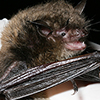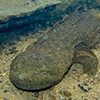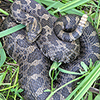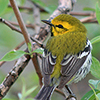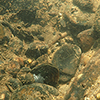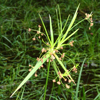Conservation Science
Protecting Pennsylvania's Plants and Animals
Species at Risk:
Wetland Butterflies
Butterflies are nested into the ecosystem of a wetland. Their delicate beauty is appreciated by observers who have learned that wetlands are an amazing place to find specialist butterflies. Adult butterflies help pollinate flowering plants, while both caterpillars and adults provide food for predators, including other insects, birds and spiders. Sadly, many species of wetland butterflies are in decline. For this reason, WPC partnered with agencies in Maryland, West Virginia and New Jersey to improve the conservation and management of 14 wetland butterfly species of concern.
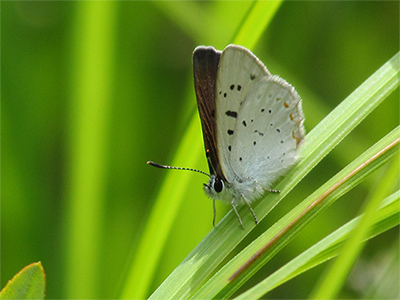
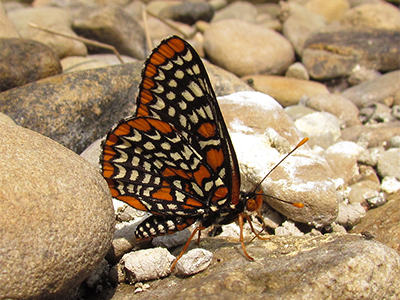
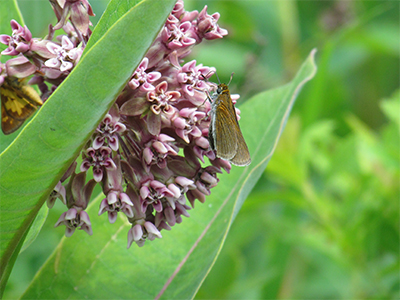
Butterflies at Risk
A variety of threats have caused wetland butterfly populations to decline. The loss and alteration of wetland habitat, over-shading by shrubs and trees, degraded water quality, climate change and habitat fragmentation have all contributed to their decline. Below you’ll find a few of the species of concern that WPC is monitoring.
Broad-Winged Skipper
The broad-winged skipper (Poanes viator) is a small, orange and brown butterfly. There are two subspecies found in Pennsylvania. Populations in southeastern Pennsylvania (subspecies zizaniae) have adapted to feed on an invasive common reed (Phragmites australis) and are locally common.
Northern and northwestern inland populations (subspecies viator) are more uncommon. They require freshwater wetlands with abundant native sedges. The broad-winged skipper is seldom found far from suitable habitat, though it will move from wetlands to adjacent upland habitats to nectar on milkweeds and other flowering plants.
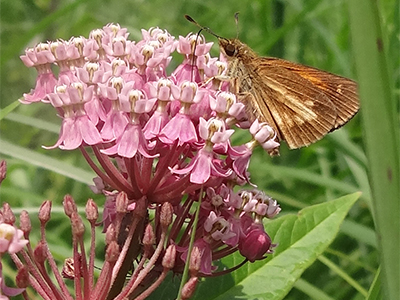
Broad-winged skipper (Poanes viator viator)
Bog Copper
The bog copper (Lycaena epixanthe) is a tiny butterfly found only in boggy habitats. The bog copper relies almost exclusively on large and small cranberry (Vaccinium macrocarpon and V. oxycoccos). Adults emerge in June and July when the cranberry is in bloom and nectar almost exclusively from cranberry flowers.
Females lay their eggs on cranberry plants that are nestled in clumps of sedges and mounds of sphagnum. They glue each egg to the underside of a cranberry leaf near the bog surface. The egg remains on its leaf all winter with a little caterpillar protected inside. The following spring, the egg hatches and the caterpillar begins feeding upon cranberry leaves. When the caterpillar is ready to pupate, it attaches to a cranberry plant. After approximately two weeks, the adult emerges and the cycle begins again.
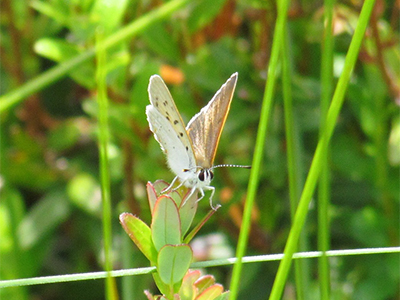
Bog copper (Lycaena epixanthe)
Dion Skipper
The dion skipper (Euphyes dion) is a large skipper found in freshwater wetlands with abundant sedges. Like most skippers, the dion skipper folds its wings neatly over its back when it lands. The undersides of its hindwings are a warm brown with the center of the hindwing marked with vague, horizontal, yellowish streaks. Male dion skippers are quick fliers and patrol a patch of sedges, watching for females. The caterpillars feed on hairy sedge (Carex lacustris) and likely other sedges as well. The caterpillars hibernate during winter and pupate in a shelter of leaves pulled together with delicate silken threads.
Baltimore Checkerspot
The Baltimore checkerspot (Euphydryas phaeton) is a handsome black butterfly checked with orange and white spots. Its common name honors the American colonist George Calvert, who was the first Lord of Baltimore and whose family crest bears the colors of black and gold. In 1973, the Baltimore checkerspot was selected as the state insect of Maryland.
Female Baltimores lay their eggs upon white turtlehead (Chelone glabra). When the eggs hatch, the tiny caterpillars crawl to the top of the plant and spin a communal web around the leaves where they can eat and rest. They spend the winter as caterpillars tucked into pockets under leaves and vegetation on the ground. In the spring they resume feeding, this time independently, before pupating and emerging as adults in early summer.
Forested and open wetlands and any moist fallow meadow can provide essential breeding and nectaring habitat for the species. Deer browse on white turtlehead is a threat to the Baltimore checkerspot. Deer like to eat the buds, flowers and leaves at the top of the plant, which reduces the plants’ ability to spread by seed and removes the tender parts of the plants where the caterpillars feed.
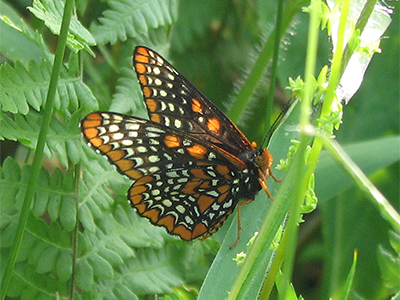
Baltimore checkerspot (Euphydryas phaeton)
Black Dash
The black dash (Euphyes conspicua) is a medium-sized sedge skipper found in open sedge-dominated wetlands. The presence of swamp milkweed is a good indicator of preferred habitat. Named for its bold black dash, males have a bright reddish-orange forewing with a broad black border. Females have a dark brown forewing with a row of creamy, jagged spots.
On males and females, look for an indistinct pale patch in the center of the hindwing that is widest in the center with a dark smudge below. The underside of the hindwing is easily visible when they are at rest with their wings folded. Caterpillars feed upon wetland sedges (Carex spp.), especially narrow-leaved ones like tussock sedge (Carex stricta).
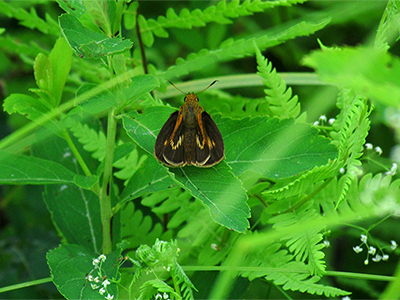
Black dash (Euphyes conspicua)
Mulberry Wing
The mulberry wing (Poanes massasoit) is a small, dark sedge skipper associated with a variety of wetlands dominated by tussock sedge (Carex stricta). Males and females are a uniform dark brown with an ephemeral sheen of purple that is only visible for a short time after emerging.
The males are unmarked, and the females have a few pale yellowish marks. Both males and females have a very distinct patch of yellow spots on the hindwing which is visible when they are at rest with their wings folded. The caterpillars feed on tussock sedge and likely other types of sedges as well. Wetland flowering plants like swamp milkweed and buttonbush are important for this butterfly since it seldom strays from its wetland home.
Harris' Checkerspot
Harris’ checkerspot (Chlosyne harrisii) is a dark orange and black butterfly with the undersides of the hindwings crisply checkered in white, orange and black. The Harris’ checkerspot is a butterfly of wet, shrubby meadows, and the edges of bogs and marshes. Ideal habitat has good stands of its larval host plant, flat-topped white aster (Doellingeria umbellatus).
The adults fly from June through early July. The caterpillars tend to be confined to a small area, which means populations are vulnerable to extirpation due to a localized disturbance that damages or destroys their host plant patch.
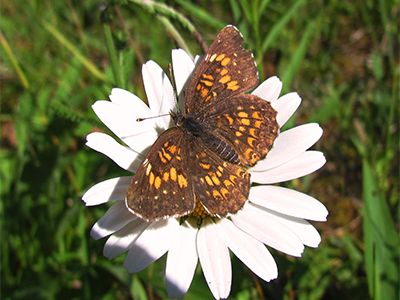
Harris’ checkerspot (Chlosyne harrisii)
Silver-Bordered Fritillary
The silver-bordered fritillary (Boloria selene) is a petite orange and black butterfly with bands of silver spots on the undersides of the hindwings. Adults are found throughout the summer in bogs, marshes and wet meadows. The caterpillars feed on violets (Viola spp.) associated with wetlands. This little fritillary has multiple generations (broods) in a year, so you can look for adults from May through September. In Pennsylvania, the silver-bordered fritillary is most commonly found in our central and northern counties at higher elevations.
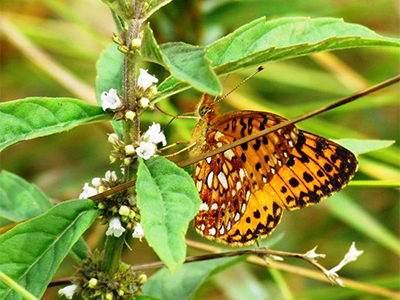
Silver-bordered fritillary (Boloria selene)
Conservation Projects
The Conservancy worked with the Maryland Department of Natural Resources, the West Virginia Maryland Department of Natural Resources and the New Jersey Department of Environmental Protection’s Endangered and Nongame Species Program to gain a better understanding of population distributions of 14 wetland butterflies. This project was funded by a Regional Conservation Needs Project and helped gather data on the status, distribution and habitat needs of rare wetland butterflies at a regional scale.
Through this joint project, WPC scientists created a regional distribution model for each of the 14 species of wetland butterflies. Distribution models identify habitats that are likely to provide good habitat for each species across the landscape. We use these models to guide our field surveys and improve our understanding of the habitat needs of these species. The models are also used in the Pennsylvania Conservation Opportunity Area tool to support conservation planning and implementation for these rare butterflies.
We also worked with our partners to create important outreach materials for local landowners, such as the Habitat Management Guide for Pollinators. Most importantly, this research helped improve our efforts to manage and restore habitats on which these imperiled butterflies depend. With the help of conservancy and agency partners, we identified 15 sites in Pennsylvania that were good candidates for habitat enhancement and/or monitoring. We completed site assessments and provided habitat management recommendations that would benefit wetland butterflies and other wildlife. We provided technical support to partners as they developed and/or implemented habitat management plans.

